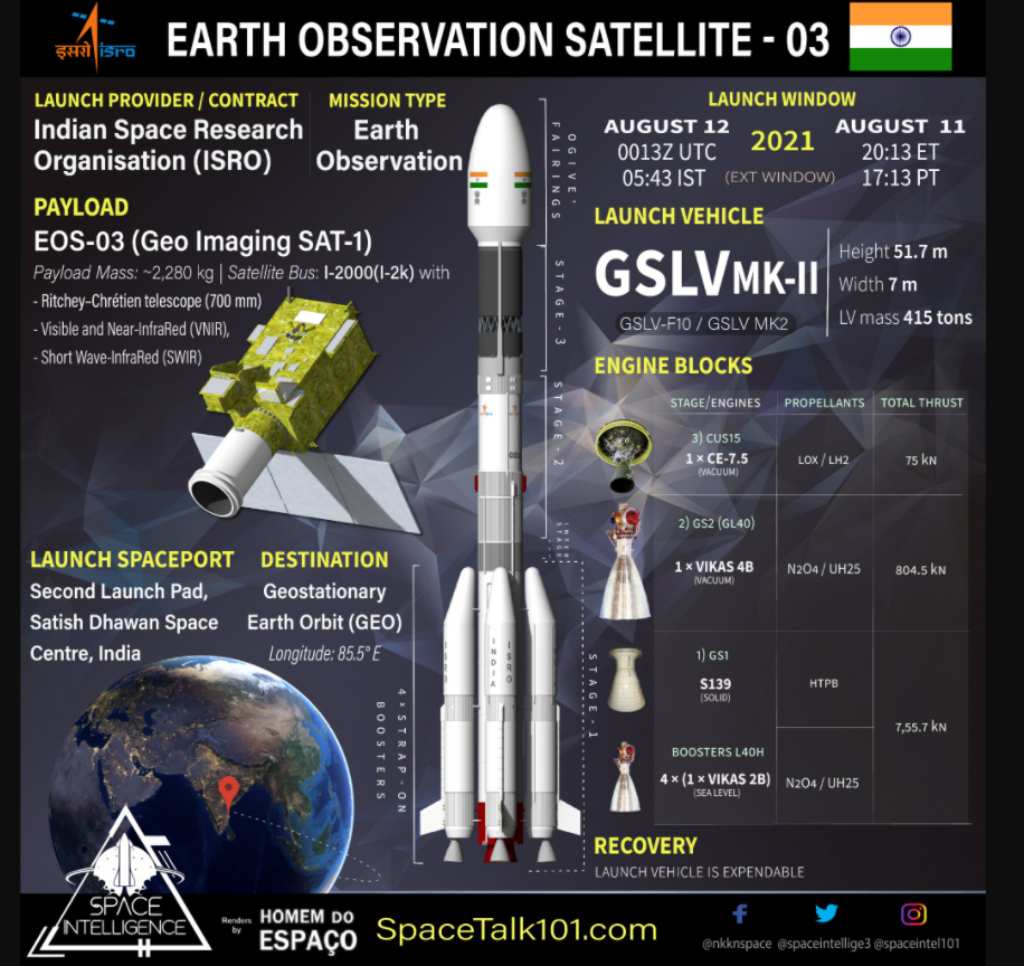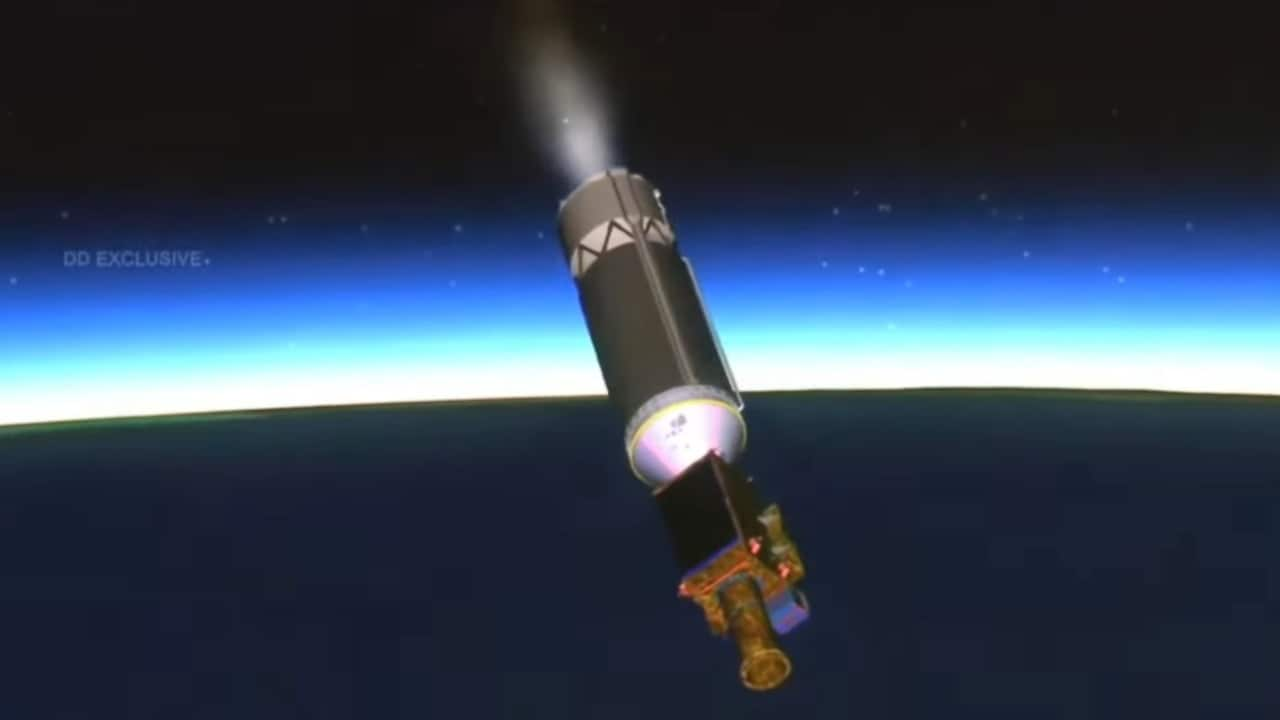Abigail BanerjiAugust 15, 2021 1:20:56 PM
The second launch of the Indian space research organization ISRO this year failed because the rocket could not bring the earth observation satellite into orbit. The launch occurred before sunrise due to a problem with the missile’s upper stage.
ISRO’s GSLV-F10 is launched with the Earth observation satellite-03 on board. Photo credit: ISRO
This satellite is an image satellite launched by the Earth Synchronous F10 (GSLV-F10) satellite launcher from the Satish Dhawan Space Center in Sriharikota, Andhra Pradesh. The launch at 5:43 a.m. IST on August 12 was successful, but the cryogenic top layer did not ignite, which disappointed ISRO.
ISRO tweeted: “The start of the GSLV-F10 took place today as planned at 5:43 am. The performance of the first and second stages was normal but extremely difficult due to technical anomalies. The low temperature ignition of the upper stage did not occur. The mission was not possible. It was achieved as desired. “
The start of the GSLV-F10 took place today as planned at 05:43 a.m. IST. The first and second stage performance was normal. However, due to a technical anomaly, a cryogenic top fire did not occur. The mission did not complete as intended.
– ISRO (@isro) August 12, 2021
Cryogenic thrusters are much more efficient than normal rocket thrusters and are ideal for spacecraft. In addition, it is so difficult to develop that few countries have managed to develop it. The 3rd stage engine from GSLV is a record holder in itself. This cryogenic engine is considered to be one of the most powerful top engines in the world.
It generates 200 kN of thrust in a vacuum and works for 640 seconds. The fuel is a mixture of oxygen and hydrogen. They are cooled to cryogenic temperatures (below -183 ° C) and are in the form of liquids.
The average cost to launch a GSLV is estimated at around 40 billion rupees, or $ 62 million, making it one of the cheapest launch vehicles in the world.
The launch got off to a difficult start as it was constantly being postponed due to pandemics or other technical issues. The satellite was originally supposed to be launched on March 5, 2020, but was canceled and rescheduled on March 28, 2021. It was also postponed and was due to start in May, but was later canceled. The second wave of COVID-19 hit and everything ended badly.
Watch live: Release of EOS-03 installed in GSLV-F10 https://t.co/NE3r VjNtHb
– ISRO (@isro) August 11, 2021
ISROs usually talk about the problem, so it is not officially known whether the satellite was in orbit or lost.
What’s wrong?
ISRO saw a smooth 26 hour countdown that began yesterday when the missile was brought to the launch pad and filled with fuel. According to space enthusiast and blogger enthusiast Karthik Naren, the final countdown and launch was successful, but five minutes later the rocket began a “pitch down range”.
Setting up the range pic.twitter.com/l2zeGXUTDn
– Karthik Naren (knkknspace) August 12, 2021
According to the PTI report, the GSLV-F10 exploded after the mission director gave the green light.
Mission Control stated that the missile’s first and second stage performance was normal.
Screen shot of ISRO mission control during the EOS-03 launch mission. Image source: ISRO / YouTube / Karthik Naren
Naren Said First Post “About five minutes after launch, the missile continued to lose its upper attitude and speed and eventually fell. The last figure shows a tendency. “
“The fairing was already separated and the satellite was exposed to a vacuum in space at an altitude of 130 km.”
After seeing scientists arguing, the Range Operations Director announced that he was “unable to complete his mission” due to “performance anomalies.”

About EOS-03. Image source: Karthik Naren
ISRO Chairman K Sivan then said: “(Mission) could not be fully completed, mainly due to the observation of technical anomalies in the cryogenic phase. I wanted to tell all my friends about it. “Announced.
“The satellite did not enter orbit because the inherent cryogenic upper stage, or CUS-15, had to burn for a few more minutes to reach orbit speed. Aim for a geosynchronous transfer orbital speed of 7.9 km / s or more. We had to reach 170x. The 36297 had an incline of 19.4 °, but that was unusual as we could only get 4.7 km / s falling the stage, ”explains Naren.
According to ISRO, the CUS-15 has to burn for a total of 13 minutes (from T + 5 minutes to T + 18 minutes 29 seconds), but problems occurred 6 minutes after ignition. ..

Screenshots from the start of the EOS-03 mission. It shows that the 3rd stage of GSLV-F10 is sloping down. Image source: ISRO / YouTube / Karthik Naren
Where are the satellites? Naren states that it may have dispersed in the Bay of Bengal and that the stage was dispersed in the Maltaban Bay area between the Andaman Islands and Thailand.
Hindustan Times The GSLV missile reports that it is not as successful as ISRO’s flagship PSLV. Three of the 14 GSLV missions failed compared to two of the 53 PSLV missions. The GSLV missile was used to launch the Chandrayaan-2 mission. This was also a partial failure as the lander-rover module collided with the moon while the orbiter continued its scientific mission. The GSLV will also launch the first Indian astronauts into space if everything goes according to plan.
“ISRO has to master the cryogenic use for future missiles. They are already working on cryogenic temperatures, but such failures are mostly Gaganyan missions and the next heavy rocket. Before that, it will create another opportunity to check the cryogenic phase. The project, ”adds Fools.
People react
In an interview with PTI, the experienced space scientist and former ISRO boss G Madhavannea was shocked about the failure of the start of the GSLV-F10. But he is also confident that ISRO will not ricochet off and lose heart, as this is not unusual.
“It’s a shock to all of us, but we’ll soon recover from that shock and get back on track. The ISRO community is resilient enough to face such challenges, ”said Nair.
“It’s a very complex task. The cryogenic phase is usually the most difficult phase compared to any other rocket engine, ”he added.
From 2003 to 2009 Nia was ISRO chief and oversaw 25 successful missions.
ISRO has mastered cryogenics for many years and has a good track record, he said. Not that bad compared to Russia and some European countries where cryogenic failures are estimated at around 20%.
“This is the eighth start in the cryogenic phase. The first start was a problem (failed. After that all other starts became textbook performance. It fails in such a complex system. The possibilities are limited. Don’t be disappointed. “
“But at the same time we have to get to the cause (of the failure) and fix it so that it doesn’t repeat itself.”
Zitendra Singh, Federal Minister for (Independent) Science and Technology; Minister of State (independent) for Geosciences; MoS PMO, Personal, Public Complaints, Pensions, Nuclear and Space said he told Shebang about his failure.
“With Dr. KSivan, the chairman of Isro, and talked about it at length. The first two steps worked, but then the cryogenic top layer became difficult to ignite. The mission may be postponed someday, ”Shin said. Via tweet.
Many people have shown their support for the National Space Agency online after ISRO announced that the mission did not go as planned. Words of encouragement and pride were poured from fans and applicants, along with some one-sided advice.
Ah!
It’s okay, you know we Indians are very proud of you. Here and there small mistakes happen again and again. ️❤️
– Lada (@elfacination) August 12, 2021
Despite the failure of today’s GSLV launch, we have to thank the entire #isro The team for the respectable work they put into this mission during such a short and challenging time in a pandemic. Despite the blockages and restrictions, they have made it so far. It was a hard day.
– #ISROfans (@Isrofans) August 12, 2021
Oh, no way. It’s ok isro don’t worry. We will always be in more stongerrisro and focus more on future missions. You did a great job in this young pandemic situation. Take Bowwisro. ❤️❤️❤️❤️❤️❤️❤️❤️❤️❤️❤️❤️❤️❤️❤️❤️❤️❤️❤️❤️❤️ pic.twitter.com/n0RgDn3rqs
– Vigneshdhoni (@ Vignesh35013754) August 12, 2021
Via satellites
GISAT weighs over 2 tons and has a service life of 10 years. For the first time, ISRO used an Ogive fairing, a classic spherical surface shell that could accommodate larger payloads.
In a press release, Shin said the Earth observation satellite (EOS-03) was an “excellent agile earth station” launched by the GSLV-F10 rocket and placed in a geostationary transfer orbit (GTO). The satellite uses its propulsion system on board to reach a geosynchronous orbit around 36,000 km from the surface of the earth.

GSLV-F10 Ogive cladding from ISRO. Photo credit: ISRO
Geosynchronous orbit means that the satellite is above the equator and always seems to be fixed at one point in the sky. However, such satellites are not immobile. All that happens is that the high orbit they are placed in “moves the satellite at the same speed as the earth’s rotation”. In this way, the movement, which is synchronized with the rotation of the earth, causes the GISAT-1 to circle the earth once every 24 hours.
EOS-03 highlights
- Provides real-time images of a wide range of interests.
- Monitoring of natural disasters, temporary events and short-term events.
- It is used for defense purposes.
ISRO loses earth observation satellites due to a disruption in level 3 of GSLV-Technology News, Firstpost
Source link ISRO loses earth observation satellites due to a disruption in level 3 of GSLV-Technology News, Firstpost

